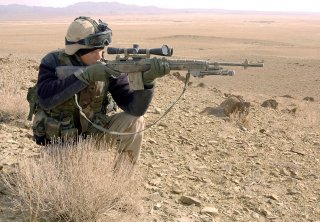The M-14: The Mighty American Battle Rifle or Vietnam Disaster?
While the M1 was a good design when it was originally fielded in the 1930s, the M1’s shortcomings quickly became apparent.
Here's What You Need to Remember: Vietnam was the M14’s proving ground. Although the rifle did benefit from good stopping power and was able to penetrate the thick brush and jungle endemic to Vietnam, its long overall length made it difficult to maneuver. Like the Garand, the M14’s barrel and receiver were mated to a wooden stock. While aesthetically pleasing, the wood did not fare well in the jungles of Southeast Asia.
In general, battle rifles are built around larger-caliber full-power cartridges that have greater range and more energy potential than those used in assault rifles, like the M16 family’s 5.56x45mm cartridge or the AK-47’s 7.62x39mm cartridge. Though battle rifles have now fallen out of favor with the world’s militaries, battle rifles were once standard issue. Meet America’s last battle rifle.
M14
The M14 was in some ways a perfection of the earlier M1 Garand rifle design that served the United States during World War II and in Korea. While the M1 was a good design when it was originally fielded in the 1930s, the M1’s shortcomings quickly became apparent.
It had a small, four-round capacity and reloaded via striper clips which was slow and time-consuming. It was also a relatively long rifle, and heavy, at around 10 pounds, or around 4.5 kilograms. The cartridge the M1 was chambered in, the .30-06 Springfield, was overpowered for the closer fighting experienced in Europe or the Pacific. Although it was a significant improvement over the bolt-action rifles it replaced, the M1’s firepower was hindered by being only semi-automatic.
The M14 design attempted to address these issues. Firing the full-sized 7.62x51mm NATO round, the robust-looking M14 could pack a punch and was accurate out to 500 to 800 yards, depending on what kind of optics the rifle was fitted with. Though slightly less powerful than the larger .30-06 cartridge, the 7.62x51mm NATO was still a powerful cartridge—too powerful.
Firing in fully automatic, the M14 was essentially uncontrollable and next to impossible to be fired accurately. It also didn’t offer any advantage in weight savings, and when loaded weighed virtually the same as an M1, even though the barrel was two inches shorter. However, reloading was much quicker via a 20-round box-type magazine.
In addition, the M14 was intended to be a logistical silver bullet. The Department of Defense hoped that the M14 would be able to replace the BAR rifle, the M1 Garand, and the various submachine guns in American service following World War Two. But, the M14 was far from perfect.
Good Morning, Vietnam
Vietnam was the M14’s proving ground. Although the rifle did benefit from good stopping power and was able to penetrate the thick brush and jungle endemic to Vietnam, its long overall length made it difficult to maneuver. Like the Garand, the M14’s barrel and receiver were mated to a wooden stock. While aesthetically pleasing, the wood did not fare well in the jungles of Southeast Asia. High humidity and frequent rains caused the wood to warp from frequent swelling and contracting, negatively affecting accuracy.
The battle rifle would serve as standard-issue for a scant seven years. In 1967 it was replaced by the venerable M16 rifle, America’s first assault rifle. The M16 and its related M4 design continue to serve the American military and quite a few other militaries around the world to this day.
Pop Culture
In popular culture, the M14 is possibly best remembered for its prominence in the 1987 hit Full Metal Jacket. In the film, the rifle is frequently on camera as the Marine unit the film follows completes boot camp prior to deploying to Vietnam. This scene from the film gives a good sense of the M14’s size and is worth the watch.
Today
Though no longer standard issue, the M14 is still used in certain niche roles where it is prized for its accuracy, range, and stopping power. The United States Marine Corps used some M14s with match-grade components and improved optics as a designated marksman rifle. A similar but improved M14 variant, the M39 Enhanced Marksman Rifle, was used in a similar role and replaced the designated marksman rifle. The Army and some Special Operations groups also use another M14 derivative, the Mk 14 Enhanced Battle Rifle in the designated marksman role.
Postscript
Fortunately or unfortunately, the M14 never served in the large European land battles it was intended for and was out-of-place in urban or jungle scenarios. Still, its superior range and stopping power compared to the M16 assault rifle keep it relevant in certain roles today—not too bad for a rifle that’s about sixty years old.
Caleb Larson holds a Master of Public Policy degree from the Willy Brandt School of Public Policy. He lives in Berlin and writes on U.S. and Russian foreign and defense policy, German politics, and culture
Image: Reuters

